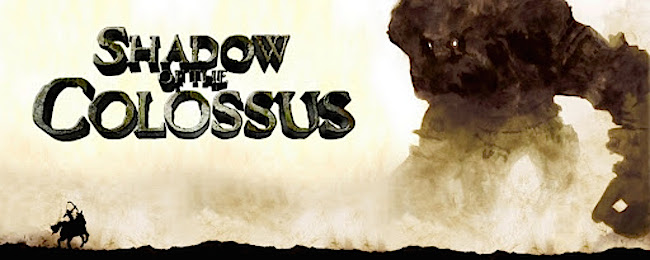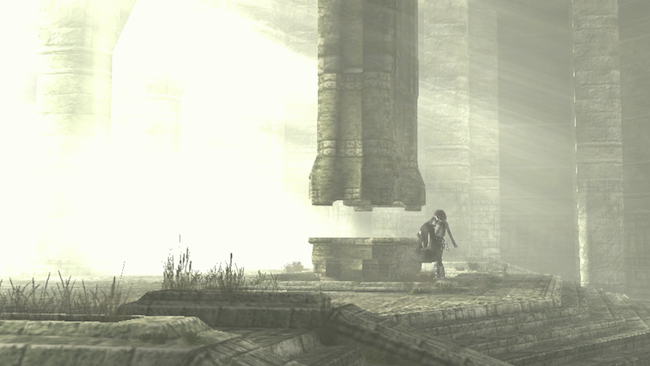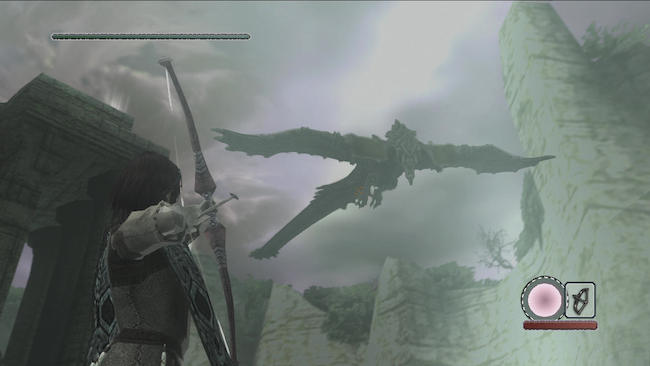
Shadow of the Colossus, released for PS2 in 2006, is a game that’s often stood at the forefront of the “games as art” debate. It was well received at the time, and equally so as part of the HD collection released on PS3 in 2011. The game has also proved to be a popular choice with critics when referencing certain design principles used in more modern games. In fact, I, myself have referenced it several times – most recently, in my retrospective review for NieR. I have a confession to make, though. Up until now, I had not actually taken the time to play it for myself and spoke only from second-hand knowledge and random gameplay footage I had seen on YouTube. It dawned on me as an aspiring professional that this was a problem, and I immediately sought to rectify this if I was going to reference it in the future.

Simplicity is a common theme in Shadow of the Colossus; which, in my opinion, can work remarkably well if it doesn’t impede the players investment in the experience. The premise for the game is straightforward in that Wander, the main protagonist, has entered the “Forbidden Land” on the back of his horse Agro with a stolen ancient sword in hand, as well as the lifeless corpse of the maiden Mono; presumed to a love interest, though never stated directly. Wander has come to the Shrine of Worship to seek the help of a powerful being named “Dormin” who can supposedly return Mono’s soul to her body. The entity is willing, but only on the condition that he first seeks out and defeats 16 giant beings known as “colossi” who roam the land. However, there will also be a great price to pay if he’s to revive Mono.
While the game itself is nearly always focused on hunting down the colossi as opposed to almost any direct narrative, the experience is consistently driven through an incredible amount of environmental storytelling. The landscape is vast and varied, and the battles with the colossi are epic, with each new area and monster portraying its own unique story to the player without the need for words. To a degree, this approach reminded me of newer games such as Dark Souls – for which I wonder if it was an inspiration. It’s interesting to note that as the player takes out each colossus, there is this heart-wreching music that plays as you land the final blow and the giant falls to the ground, lifeless; almost implying that you’ve done a terrible thing. There are many subtle hints at a bigger picture throughout, but rest assured, there is enough direct narrative towards the end to quench your suspicion and conclude the game in a strong way. The concept might be simple, but it’s also powerful, and there are several moments that pack an emotional wallop.

Shadow of the Colossus was an innovative game for its time, and one which has notably been emulated by other contemporary games such as Castlevania: The Lords of Shadow and Dragon’s Dogma. The special thing about the design of this particular game is that the world is entirely devoid of all civilisation. It is just the player, Agro (the horse), and the colossi who populate the land, so there are very little distractions while you play. Basically, it’s split into two primary activities, the first of which is hunting the colossi, which is done with the ancient sword which will point the way when standing in direct sunlight. Again, it sounds simple, but the terrain is tricky, and will often provide as much of a challenge as the encounters themselves. The second activity is the battle with the giants, which grows progressively difficult with time, but always relies on brains over brawn and a healthy combination of puzzle-solving and platforming.
Each encounter with a colossus is unique and often employs a special way to climb onto the giant or to track down its various weak points. It might appear easy enough, but this couldn’t be further from the truth. In the beginning, the creatures are a lot more passive, so you have the space to experiment while mostly worrying about platforming, but as you progress, the weak spots become more tricky to find, the colossi grow increasingly aggressive, and it becomes very challenging to find a way to scamper up the beasts – this is most notable with the swimming and flying variety. In fact, more often than not, the environment is brought into the mix of battle, which I thought worked especially well to step past the conventional boss battles of even today’s games in order to keep the player guessing. There are subtle hints provided by Dormin on occasion, but you will really need to think outside the box in order to succeed. If you can resist the urge to cheat, I can guarantee that the colossi are some of the greatest boss encounters in any game, ever.

I think it’s fair to say that by today’s standards, even when playing with a DualShock 4, that the controls feel a bit archaic. They’re not exactly clunky, but they’re also not configured in a way that feels overly empowering (though, you could say that’s a part of its charm). It’s nice that you are given the option to remap the buttons at least, which I did almost as soon as I realised. If I were to pinpoint my frustration, though, it would be with the camera and what it perceives is the best angle, especially when riding on Agro – although, there is a dedicated button that will focus on a colossus during battle, which helps to improve your control. In hindsight, however, I think that it would have fit fairly comfortably with how other games from the same era controlled, and the truth is it never impedes your ability to play.
On the other hand, there were a lot of revolutionary gameplay ideas which would set the standard for years to come. From shooting arrows while riding on horseback to a climbing mechanic that allows you to scale the largest foes as they try to fling you around, it all works together in unison to create a tightly crafted action adventure experience. It’s also one of the best examples of a truly open world from an era where many games could only dream of achieving its scope. You don’t have the ability to level up or gain new equipment like with other notable adventure titles such as Zelda, but your grip meter will grow larger for every Colossus you manage to defeat. Throughout the game, and with each new challenge, you will slowly be called upon to use and master the various quirks and smaller mechanics in combat that otherwise could have gone wasted. It’s a joy to play, even if it’s now starting to show a few signs of age.

I remember seeing footage from Shadow of the Colossus many years ago and being very impressed. It’s an attractive game, and for me, having played the HD version on the PS3, it was doubly so. In the updated version of the game, the aliasing has been cleaned up, the textures are a lot clearer, and the frame-rate is greatly improved. It’s not a complete remake or even a re-skinning, but it does demonstrate the level of detail that went into it in the first place; that it could so comfortably translate to the HD era and even look better than a lot of games made for those platforms.
What makes a Team Ico game standout, however, is the artwork, and for this reason I understand now why this title has often been used when debating games as an art form. The sheer scale of the colossi and the landscapes can be genuinely breathtaking at times, even in retrospective, and this success is also due in part to an excellent balance with the soundtrack. While riding across the plains, for example, there is often no music whatsoever. Everything is queued with what you’re doing, so, when you finally cling to a colossus, you know that you’re on the right track as the music will shift to an exciting, adventurous tune. Although, as mentioned earlier, once you deliver that final blow, and that tragic tune kicks in, it says more than any words could. The colossi are some of the most incredible creatures I’ve seen in a game, and every time one fell to the ground lifeless, I genuinely felt sad for it as it were actually a living thing.
Shadow of the Colossus is a game I should’ve played along time ago. Sure, I got to benefit from the HD upgrade, but I think this is an experience that would’ve persevered regardless of the platform. There’s beauty in simplicity, and that is the fundamental design principle at work here. The narrative is straightforward, the goal of the player is simple, and yet, within this big, open, and empty world, there is a sense of life and tranquility that is utterly captivating. Each colossi is unique in its own way, and while it is exciting to hunt them down and defeat them in a battle of wits, there’s also a heart-wretching feeling when the light in their eyes finally goes out. If anything, it could benefit from an updated control and camera configuration, but apart from some minor frustrations expected with an older game, I walked away inspired by the experience.











